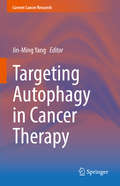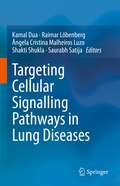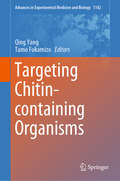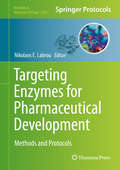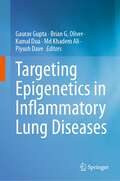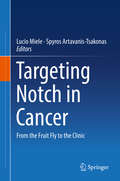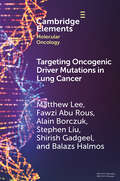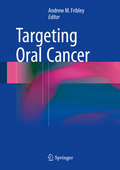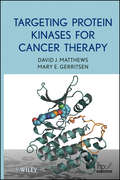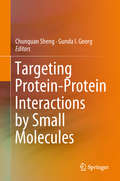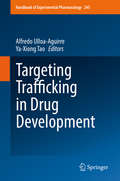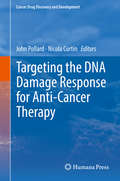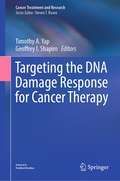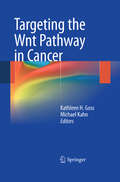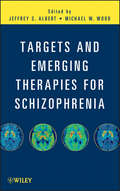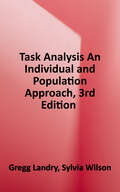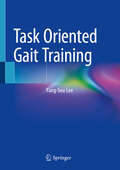- Table View
- List View
Targeted Therapy of Colorectal Cancer Subtypes (Advances in Experimental Medicine and Biology #1110)
by Peter JordanColorectal cancer (CRC) is a leading cause of cancer-related death worldwide. Recent years have increased significantly our understanding of the genetic alterations that can underlie CRC, but also unraveled the molecular heterogeneity of the disease. Although a simple correlation between genetic pathways, histopathological features and clinical outcome cannot be established, the heterogeneity of CRC is also an opportunity for the development of targeted therapeutic approaches, able to treat an individual tumor with higher efficiency and less toxic side effects. One CRC subtype is characterized by high mutation rates (MSI-H), DNA methylation changes (CIMP-H), mutation in the BRAF oncogene and occurrence of serrated adenomas in the proximal colon. Other groups prevail in the distal colon and consist of either adenomatous polyps with chromosomal aberrations (CIN) and WNT pathway activation, or carry frequent KRAS mutation and metabolic deregulation, or have strong mesenchymal and infiltrative characteristics. Characterization of driver-mutation events in these CRC subgroups has led to the development of specific drugs targeting, for example, the MAPK pathway, but initial clinical trials have revealed unexpected response rates. The collection of chapters in this volume address the biology of specific CRC subtypes and how these may be targeted to improve precision therapy and clinical benefit for the patients.
Targeting Autophagy in Cancer Therapy
by Jin-Ming YangThis volume will detail the current state and perspectives of autophagy-based cancer therapy. Covering a wide range of topics, it will include an overview of autophagy as a therapeutic target in cancer, autophagy modulators as cancer therapeutic agents, implications of micro-RNA-regulated autophagy in cancer therapy, modulation of autophagy through targeting PI3 kinase in cancer therapy, targeting autophagy in cancer stem cells, and roles of autophagy in cancer immunotherapy. In addition, the volume will review applications of system biology and bioinformatics approaches to discovering cancer therapeutic targets in the autophagy regulatory network. The volume will be beneficial for a variety of basic and clinical scientists, including cancer biologists, autophagy researchers, pharmacologists, and clinical oncologists who wish to delve more deeply into this field of cancer research. This volume will be the first book to focus solely on autophagy as a target in cancer therapy. As well, it will comprehensively discuss the roles of autophagy in most currently available cancer treatments.
Targeting Biofilms in Translational Research, Device Development, and Industrial Sectors
by Dustin L. WilliamsThis book offers a much-needed discussion on the targeting of biofilm-related infections. Chapters include discussions on the impact of biofilm on medical implants, industrial applications, as well as wound and tissue infections. It also offers discussions on regulatory management for industrial sectors and medical environments. Given that there continues to be a paucity of effective antimicrobial products, devices, and coatings in clinical and industrial use that effectively reduce rates of infection or biofilm-related problems, Targeting Biofilms in Translational Research, Device Development, and Industrial Sectors, offers a fresh and much-needed perspective aimed at helping create healthier controlled environments and safer devices. This comprehensive book is indispensable for industrial and academic translational researchers, device developers, and regulatory experts looking to create more effective antimicrobial products.
Targeting Cellular Signalling Pathways in Lung Diseases
by Shakti Shukla Kamal Dua Raimar Löbenberg Ângela Cristina Malheiros Luzo Saurabh SatijaThe book comprehensively reviews and provides detailed insight into the cellular and molecular signalling mechanisms involved in pathophysiology of various respiratory diseases, towards developing effective therapeutic strategies in the management and treatment of lung disease. It also covers promising advances in the field of therapeutics that could lead to novel clinical therapies capable of preventing or reversing the disease features including novel strategies for targeting chronic lung diseases using advanced drug delivery systems. Importantly, the book examines the significance and relevance of the plant extracts and their constituents with therapeutic efficiencies against lung diseases. As such, the book offers a blend of translational, biological, chemical, and drug delivery aspects relevant to respiratory diseases, thus, offering a valuable resource for pulmonologists and translational researchers working in the field of pulmonary biology and respiratory medicine.
Targeting Chitin-containing Organisms (Advances in Experimental Medicine and Biology #1142)
by Qing Yang Tamo FukamizoThis book provides a comprehensive overview of chitin biology and chitin metabolism related enzymes. Chitin, the second most abundant biopolymer in nature after to cellulose, is a linear biopolymer composed of β-1,4-linked N-acetylglucosamine (GlcNAc), and an essential component in the exoskeletons of insects, mites, ticks and crustaceans, the egg shells of parasitic nematodes, and fungal cell walls. Although some chitin-containing organisms are a threat to human health, food safety and agricultural production, non-chitin containing organisms like humans, mammals and plants have an innate immune response to these hazardous organisms. The book provides researchers and students with information on the recent research advances concerning the biology of chitin-containing organisms as well as cross-talks between chitin-containing and non-chitin-containing organisms. Highlighting chitin remodeling enzymes and inhibitors, it also offers drug developers essential insights into designing specific molecules for the control of hazardous chitin-containing organisms.
Targeting Enzymes for Pharmaceutical Development: Methods and Protocols (Methods in Molecular Biology #2089)
by Nikolaos E. LabrouThis volume explores detailed methods and experimental protocols evaluating the effect of a compound or a mixture of compounds on the action of enzymes that are significant targets in pharmaceuticals. Consisting of three sections, the book delves into recent biocomputing and bioinformatics protocols, state-of-the art modern biophysical, electrophoretic, and chromatographic methods and high-throughput screening approaches, as well as detailed protocols and examples of the inhibition analysis and evaluation of selected enzymes. Written for the highly successful Methods in Molecular Biology series, chapters include introductions to their respective topics, lists of the necessary materials and reagents, step-by-step, readily reproducible laboratory protocols, and tips on troubleshooting and avoiding known pitfalls. Authoritative and cutting-edge, Targeting Enzymes for Pharmaceutical Development: Methods and Protocols serves as a vital reference for academics and industry professionals working on expanding our understanding of the wide range of important enzyme targets.
Targeting Epigenetics in Inflammatory Lung Diseases
by Gaurav Gupta Kamal Dua Brian G. Oliver Md Khadem Ali Piyush DaveThis book discusses the role of epigenetics in pathogenesis of different pulmonary diseases, including chronic obstructive pulmonary disease, lung cancer, pulmonary tuberculosis, idiopathic pulmonary fibrosis and pulmonary infections. It also explores post-translational modifications in DNA and histones for improving the understanding of lung diseases. This book helps in understanding the epigenetic mechanisms towards the development of novel diagnostic and therapeutic approaches. Further, the book provides insight into the underlying molecular mechanisms involved in the epigenetic regulation of inflammation, which may have novel implications in designing small molecule inhibitors that target the epigenetic machinery for the effective treatment of a variety of inflammation‑related diseases. This book is a valuable resource for academics, research and industry professionals working in respiratory biology.
Targeting Lysine Demethylases in Cancer and Other Human Diseases (Advances in Experimental Medicine and Biology #1433)
by Qin YanThis book provides a comprehensive summary of our current knowledge on lysine demethylases, a class of epigenetic regulators. It takes the reader on an exciting journey spanning the past two decades, starting from the initial discovery and characterization of these enzymes and leading up to the development of their small molecule modulators. These modulators have shown promise in clinical trials and hold great potential to improve patient outcomes. The book captures the progress made in this field and highlights the significant advancements that have paved the way for potential therapeutic applications.The book covers a wide range of topics, spanning both basic biology and clinical implications associated with lysine demethylases. It offers a comprehensive historical and conceptual framework for the discovery and characterization of similar epigenetic enzymes or modulators. Chapter one serves as an introductory overview, providing insights into the general characteristics and functions of lysine demethylases. In subsequent chapters, specifically chapters two to eight, each major family of lysine demethylases is individually explored in depth. By providing in-depth insights into the functional aspects of these enzymes, the book allows readers to grasp their significance in regulating cellular processes and influencing pathogenesis. Moreover, the book goes beyond fundamental knowledge and also explores the development of diagnostic and therapeutic strategies related to lysine demethylases. It highlights the potential for utilizing these enzymes as therapeutic targets for the treatment of various diseases, including cancer and infectious diseases. Additionally, the book highlights future directions aimed at further unraveling the roles of lysine demethylases and translating these findings into the clinic.
Targeting Notch in Cancer: From the Fruit Fly to the Clinic
by Lucio Miele Spyros Artavanis-TsakonasThe serendipitously discovered link between developmental biology and cancer, touched of an explosion of discoveries on the role of Notch in human malignancies, including every aspect of cancer biology, from control of differentiation, proliferation and apoptosis in transformed cells to angiogenesis, tumor-stroma interaction and anti-cancer immune responses. A number of observations have revealed that Notch even plays a role in the renewal of cancer stem cells and tumor initiating cells, which are thought to be a major cause of resistance to treatment. Targeting Notch in Cancer will provide researchers, oncologists, pharmacologists and students with a detailed understanding of the intricate cross-talk between Notch and other pathways of therapeutic interest so to better design rational drug combinations for specific diseases and disease subsets. Divided into two parts, Part I describes in detail what we know about the genetics, molecular biology, biochemistry and structural biology of Notch, as well as the role of Notch in such processes as angiogenesis and immune surveillance. Without insights gained from these basic studies, rational targeting of Notch in human disease would be impossible. Part II describes the role of Notch and ongoing experimental therapeutic efforts in the most important subtypes of human cancers, organized in a clinically oriented fashion by organs and systems affected
Targeting Oncogenic Driver Mutations in Lung Cancer (Elements in Molecular Oncology)
by Matthew Lee Shirish Gadgeel Balazs Halmos Fawzi Abu Rous Alain Borczuk Stephen LiuThe recent advances in the field of molecular diagnostic techniques have led to the identification of targetable alterations prompting a paradigm shift in the management of non-small cell lung cancer (NSCLC) and an era of precision oncology. This Element highlights the most clinically relevant oncogenic drivers other than EGFR, their management and current advancements in treatment. It also examines the different challenges in resistance to targeted therapies and diagnostic dilemmas for each oncogenic driver and the future direction of NSCLC management.
Targeting Oral Cancer
by Andrew M. FribleyThis book provides research-oriented care providers with up-to-date information on the oral cancer patient population, the ways in which we are treating them, and the scientific approaches being pursued in order to improve survival and reduce treatment-related morbidity. The text is organized into three sections covering epidemiology and management, cancer development and biomarkers, and breaking developments and novel approaches for drug discovery. The first section includes discussion of the emerging role of HPV in oral cancer and explains the surgical, chemotherapy and radiation approaches to treatment. Aspects such as molecular progression, the role of cancer stem cells in tumor development, and the value of various biomarkers are then examined. The final section is devoted to the latest advances and covers, among other topics, current clinical trials, emerging drug targets, and targeting of the unfolded protein response and of mediators of coagulation.
Targeting Protein Kinases for Cancer Therapy
by David J. Matthews Mary E. GerritsenAn expert guide to targeting protein kinases in cancer therapyResearch has shown that protein kinases can instigate the formation and spread of cancer when they transmit faulty signals inside cells. Because of this fact, pharmaceutical scientists have targeted kinases for intensive study, and have been working to develop medicinal roadblocks to sever their malignant means of communication.Complete with full-color presentations, Targeting Protein Kinases for Cancer Therapy defines the structural features of protein kinases and examines their cellular functions. Combining kinase biology with chemistry and pharmacology applications, this book enlists emerging data to drive the discovery of new cancer-fighting drugs. Valuable information includes:Comprehensive overviews of the major kinase families involved in oncology, integrating protein structure and function, and providing important tools to assist pharmaceutical researchers to understand and work in this dynamic area of cancer drug researchFocus on small molecule inhibitors as well as other therapeutic modalitiesDiscussion of kinase inhibitors that have entered clinical trials for the treatment of cancer, with an emphasis on molecules that have progressed to late stage clinical trials and, in a few cases, to marketProviding a platform for further study, this important work reviews both the successes and challenges of kinase inhibitor therapy, and provides insight into future directions in the war against cancer.
Targeting Protein-Protein Interactions by Small Molecules
by Chunquan Sheng Gunda I. GeorgThis book comprehensively reviews the state-of-the-art strategies developed for protein-protein interaction (PPI) inhibitors, and highlights the success stories in new drug discovery and development. Consisting of two parts with twelve chapters, it demonstrates the design strategies and case studies of small molecule PPI inhibitors. The first part discusses various discovery strategies for small molecule PPI inhibitors, such as high throughput screening, hot spot-based design, computational approaches, and fragment-based design. The second part presents recent advances in small molecule inhibitors, focusing on clinical candidates and new PPI targets. This book has broad appeal and is of significant interest to the pharmaceutical science and medicinal chemistry communities.
Targeting Trafficking in Drug Development (Handbook of Experimental Pharmacology #245)
by Alfredo Ulloa-Aguirre Ya-Xiong TaoCellular trafficking is only recently identified as a site for therapeutic intervention. This book provides up to date information on the mechanism for exploiting this area for drug development as well as a clear understanding of the individual components of cellular trafficking. The authors are experts in their areas and the book features tables and figures that enable comparison and clear understanding.
Targeting the Broadly Pathogenic Kynurenine Pathway
by Sandeep MittalTryptophan metabolism via kynurenine pathway plays a critical role in both health and a variety of human diseases. This book highlights the known associations between kynurenine pathway and various disease states, as well as examines the current status of drug development and clinical trials of compounds known to alter tryptophan metabolism. The research plays a critical role in molecular targeted therapies directed at altering the kynurenine pathway of tryptophan metabolism. The initial and rate-limiting step of tryptophan metabolism is mediated by one of two enzymes, tryptophan-2,3-dioxygenase (TDO; predominantly in the liver, but also in the brain) and indoleamine-2,3-dioxygenase (IDO; in a host of tissues in response to immune activation). Targeting the enzymes IDO and TDO, as well as other downstream effectors would therefore be likely to generate novel treatment options that would be helpful in a wide variety of clinical settings. This book provides a unique bridge between basic mechanistic understanding of the role of the kynurenine pathway with translational applications and clinical relevance. It will explore the indications that tryptophan metabolism is a potential biomarker of disease activity, can contribute to local and possibly systemic immune suppression in cancer, and is an attractive target for which a variety of inhibitors are readily available.
Targeting the DNA Damage Response for Anti-Cancer Therapy (Cancer Drug Discovery and Development)
by Nicola Curtin John PollardOver the past decade a complex role for DNA damage response (DDR) in tumorigenesis has emerged. A proficient DDR has been shown to be a primary cause for cellular resistance to the very many DNA damaging drugs, and IR, that are widely used as standard-of-care across multiple cancer types. It has also been shown that defects in this network, predominantly within the ATM mediated signaling pathway, are commonly observed in cancers and may be a primary event during tumorigenesis. Such defects may promote a genomically unstable environment, facilitating the persistence of mutations, any of which may provide a growth or survival advantage to the developing tumor. In addition, these somatic defects provide opportunities to exploit a reliance on remaining repair pathways for survival, a process which has been termed synthetic lethality. As a result of all these observations there has been a great interest in targeting the DDR to provide anti-cancer agents that may have benefit as monotherapy in cancers with high background DNA damage levels or as a means to increase the efficacy of DNA damaging drugs and IR. In this book we will review a series of important topics that are of great interest to a broad range of academic, industrial and clinical researchers, including the basic science of the DDR, its role in tumorigenesis and in dictating response to DNA damaging drugs and IR. Additionally, we will focus on the several proteins that have been targeted in attempts to provide drug candidates, each of which appear to have quite distinct profiles and could represent very different opportunities to provide patient benefit.
Targeting the DNA Damage Response for Cancer Therapy (Cancer Treatment and Research #186)
by Timothy A. Yap Geoffrey I. ShapiroThis book discusses the latest developments in Poly (ADP-ribose) polymerase (PARP) inhibitor drug development. It focuses on the translational and clinical development of the latest drugs, as well as the evidence for regulatory approval of PARP inhibitors in multiple different molecular subtypes and tumor indications. The most-up-to-date information on basic scientific research on DNA repair pathways and the DNA Damage Response (DDR) is also covered. Every chapter contains insight into the preclinical, translational along with clinical aspects of a specific DDR inhibitor with key and expert opinion points reinforcing the most important concepts detailed to enable the reader to develop a deep understanding of the topic.Targeting the DNA Damage Response for Cancer Therapy comprehensively reviews the application of PARP and other DDR inhibitors across oncology disciplines. Therefore, it is a valuable resource for all medical professionals and researchers who use or who are researching the use of these inhibitors on a day-to-day basis.
Targeting the Wnt Pathway in Cancer
by Kathleen H. Goss Michael KahnInappropriate activation of the Wnt signaling pathway is observed in many human cancers and is sufficient to drive tumor initiation and progression in numerous contexts. Multiple mechanisms, such as overexpression of Wnt ligands, inactivation of the APC and Axin tumor suppressors, and mutation of -catenin, are responsible for pathway activation in tumor cells. The development of potent Wnt pathway antagonists for therapeutic use has been a major effort for investigators in both academia and industry in recent years. This book will provide an overview of the Wnt pathway as a therapeutic target for cancer, and discuss the preclinical development of inhibitors specifically directed to upstream and downstream components of the pathway.
Targets and Emerging Therapies for Schizophrenia
by Jeffrey S. Albert Michael W. WoodNew and emerging directions in pharmaceutical research to better treat schizophreniaAlthough the dopamine hypothesis has been the cornerstone of schizophrenia therapeutics, it is clear that dopamine-based approaches do not treat all aspects of the disease. Moreover, many schizophrenia patients fail to respond to current antipsychotics. Integrating chemistry, biology, and pharmacology, this book explores emerging directions in pharmaceutical research for drug targeting and discovery in order to find more effective treatments for schizophrenia, one of the most serious and widespread psychiatric diseases.Targets and Emerging Therapies for Schizophrenia presents the basics of schizophrenia, drug targets for the disease, and potential new drugs and therapeutics. It begins with a discussion of prevalence and etiology. Then, it describes therapies such as dopamine agonists and phosphodiesterase (PDE) inhibitors as well as growing research aimed at addressing untreated symptoms. Next, the authors discuss receptor modulators, inhibitors, and targeting strategies for drug discovery. Both the neurobiological and chemical aspects of all major pharmacological targets are examined.With contributions from an international team of pioneering pharmaceutical researchers, this book compiles the current knowledge in the field, setting the stage for new breakthroughs in the treatment of schizophrenia. Targets and Emerging Therapies for Schizophrenia:Provides a comprehensive resource for neuro-drug discovery and the development of molecular targets for schizophrenia treatmentDraws from chemistry, biology, and pharmacology for more effective drug targeting and discoveryExplores a wide range of receptors and molecular targets, including dopamine, PDEs, and neuropeptidesWith Targets and Emerging Therapies for Schizophrenia as their guide, drug discovery and development scientists have the information they need to advance their own research so that new, more effective treatments for schizophrenia will soon be a reality.
Targets of Cancer Diagnosis and Treatment: Ion Transport in Tumor Biology (Reviews of Physiology, Biochemistry and Pharmacology #183)
by Christian Stock Luis A. PardoThis third and final volume in the "Ion Transport in Tumor Biology" collection presents novel diagnostic and therapeutic approaches in cancer based on the exploitation of ion transport proteins. The authors critically examine several transportome members, particularly Na+, K+, Ca2+, and Cl- channels, as well as organic solute carriers regarding their suitability as therapeutic targets. Synergistic effects resulting from the combined use of classical cytostatics with ion transport-inhibiting drugs are pointed out, and the capability of bispecific antibodies to function as anticancer drugs is discussed. As readers will also learn, the use of ion channel inhibitors could improve the outcome of radiotherapy because the development of radio-resistance during radiotherapeutic treatment often correlates with increases in the expression levels and conductance of ion channels. The translational topics of this volume form a bridge between biochemical research and therapeutic application. As part of a three-volume collection, this book will fascinate members of the active research community, as well as clinicians in the cancer field.
Tartamudez: La Naturaleza Y Un Enfoque Práctico Para El Tratamiento
by A. N. Okonoboh¿Acaso es posible dejar de tartamudear en 10 días? Como tartamudo, ¿cuál es tu más grande sueño? Es entendible que no quieras que nadie simpatice con tu condición. En nuestro libro, TARTAMUDEZ, lidiamos con tu condición. Sabemos que la respuesta a la pregunta “¿cómo dejar de tartamudear?” es algo que muchas personas con esta condición anhelan saber. De hecho, sabemos que, en los grupos de tartamudeo, a muchos pacientes se les ha dicho que no se molesten en buscar un tratamiento; que tales esfuerzos son incluso más devastadores que el impedimento en sí. Bueno, es suficiente que sepas que nuestros métodos han ayudado ya a bastantes personas a superar su condición. Este libro se basa en un estudio realizado gracias a la ayuda de varias personas que han superado su tartamudez. Esto significa que este libro no contiene teorías intelectuales de laboratorio. Es un estudio práctico y real que funciona en personas prácticas y reales.
Taschenbuch Notaufnahme
by Andreas Schubert Tina KintzelWenn’s schnell gehen muss <P><P>Was macht man, wenn ein Patient vom Notarztwagen mit einer Erkrankung angemeldet wird, mit der die Pflegefachkraft lange nichts mehr zu tun hatte? Jetzt ist keine Zeit zu verlieren! Welche Utensilien müssen gerichtet werden, welche Medikamente werden benötigt, wie gibt man in Windeseile eine erste Einschätzung des EKGs ab? Übersichtlich und in knappen Worten gibt das Buch Antwort auf diese und viele weitere Fragen. Damit Sie sicher handeln können!
Task Analysis: An Individual, Group, and Population Approach
by Sylvia Wilson Gregg LandryTask analysis, the process of analyzing the dynamic relation among a client, a selected task, and specific contexts, is a critical clinical reasoning tool for evaluating occupational performance. <P><P>This new edition of this foundational text guides occupational therapy practitioners in using task analysis to understand clients and their ability to perform specific, purposeful activities.
Task Oriented Gait Training
by Yang-Soo LeeSafe and independent gait is one of the most important physical function of human. Gait training is essential to people with gait difficulty. Although there are many types of gait training strategy, there are no consensus on which one is the best. Gait training strategy can be divided into compensatory approaches and restorative approaches. Although people with severe impairment wish to restore normal walking, it is too difficult to use their involved body part normally in gait. Also, people use compensatory approaches in gait even in training session. Therefore forced use of involved body part is indispensable in gait training topeople with severe impairment. This book introduces new gait training frame which uses forced use of affected body part. First, strengthening of weakened muscle, second, step up with affected lower limb, third, step down with weight support with affected lower limb, and fourth is step down touch. Actual gait training starts after people can support their body weight and maintain balance with affected lower limb, without using hand. With this approach, people can restore impaired body function, regain more normal gait, and canreach optimal outcome.
Tasks for the Veterinary Assistant
by Paula Pattengale Teresa SonsthagenTasks for the Veterinary Assistant, Third Edition provides practical, step-by-step instructions for preparing and performing a wide range of veterinary assisting tasks. With expanded coverage of large animal and exotic restraint, anatomy and physiology, nutrition and feeding, digital radiography, and electronic medical records and client communication, this revised edition now includes why and when to perform each task with the preparation and procedure information. The book includes everything from appearance and professional language to equipment maintenance and dental and surgical assisting, making it equally useful for learning new techniques or as a memory refresher.Offering a detailed, comprehensive guide to all aspects of veterinary assisting, the book is written using an accessible, user-friendly style. A companion website offers figures from the book, downloadable flash cards, lesson plans, exams, a competency checklist, and concept maps. Tasks for the Veterinary Assistant is equally useful for acquiring new skills and gaining confidence in the veterinary practice, making it invaluable for veterinary assistant students and veterinary assistants of all experience levels.

